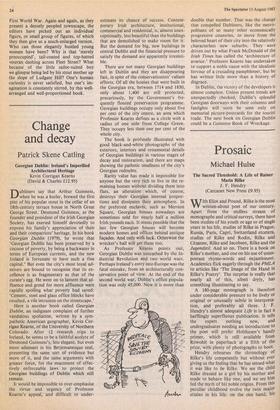Change and decay
Patrick Skene Catling
Georgian Dublin: Ireland's Imperilled Architectural Heritage Kevin Corrigan Kearns (David & Charles £12.95)
nubtiners say that Arthur Guinness, when he was a butler, brewed the first pint of his popular stout in the cellar of an 18th-century terrace house in North Great George Street. Desmond Guinness, as the founder and president of the Irish Georgian Society, has exerted himself devotedly to express his family's appreciation of their and their compatriots' heritage. In his book Georgian Dublin (1979), he wrote that `Georgian Dublin has been preserved by a cocoon of poverty, by being a backwater in terms of European currents, and the new Ireland is fortunate to have such a fine capital.' But even the city's most loyal ad- mirers are bound to recognise that its ex- cellence is as fragmentary as that of the curate's egg. He went on to lament that af- fluence and greed for more affluence were rapidly spoiling what poverty had saved: 'Cement, steel and glass office blocks have resulted, a vile intrusion on the streetscape.'
Here is another book called Georgian Dublin, an indignant complaint of further vandalous spoliation, written by a sym- pathetic American geographer, Kevin Cor- rigan Kearns, of the University of Northern Colorado. After 12 research trips to Ireland, he seems to be a faithful acolyte of Desmond Guinness's, less elegant, but even more adamant in his Betjemanesque zeal, presenting the same sort of evidence but more of it, and the same arguments with greater force, for the enactment of effec- tively enforceable laws to protect the Georgian buildings of Dublin which still remain.
It would be impossible to over-emphasise the virtue and urgency of Professor Kearns's appeal, and difficult to under-
estimate its chance of success. Contem- porary Irish architecture, institutional, commercial and residential, is, almost unex- ceptionally, less beautiful than the buildings that are demolished to make room for it. But the demand for big, new buildings in central Dublin and the financial pressure to satisfy the demand are apparently irresisti- ble.
There are not many Georgian buildings left in Dublin and they are disappearing fast, in spite of the conservationists' valiant efforts. Of all the houses that were built in the Georgian era, between 1714 and 1830, only about 1,400 are still protected, precariously, by the Government's fre- quently flouted preservation programme. Georgian buildings occupy only about five per cent of the city centre, an area which Professor Kearns defines as a circle with a radius of one mile from College Green. They occupy less than one per cent of the whole city.
The book is profusely illustrated with good black-and-white photographs of the exteriors, interiors and ornamental details of Georgian buildings in various stages of decay and restoration, and there are maps showing the pathetic smallness of the city's Georgian redoubts.
Rarity value has made it impossible for anyone but the very rich to live in the re- maining houses without dividing them into flats, an alteration which, of course, destroys their Georgian internal propor- tions and dissipates their atmosphere. In the preferred enclaves, such as Merrion Square, Georgian houses nowadays are sometimes sold for nearly half a million Irish pounds each. It seems possible that the last few Georgian houses will become modern homes and offices behind antique façades. And only with luck. Otherwise the wrecker's ball will get them too.
As Professor Kearns points out, Georgian Dublin was unscathed by the In- dustrial Revolution and two world wars. Perhaps Ireland's entry into Europe was the fatal mistake, from an architecturally con- servative point of view. At the end of the second world war, Dublin's office popula- tion was only 45,000. Now it is more than
double that number. That was the change that compelled Dubliners, like the metro- politans of so many other economically progressive countries, to move from the beloved heart of their city into the relatively characterless new suburbs. They were driven out by what Frank McDonald of the Irish Times has called the 'architecture of avarice.' Professor Kearns has undertaken to support a noble cause with the idealistic fervour of a crusading pamphleteer, but he has written Little more than a history of disgrace.
In Dublin, the victory of the developers is almost complete. Unless present trends are unexpectedly checked, Dublin's splendid Georgian doorways with their columns and fanlights will soon be seen only on memorial picture-postcards for the tourist trade. The next book on Georgian Dublin could be a Guinness Book of Wreckage.






































 Previous page
Previous page